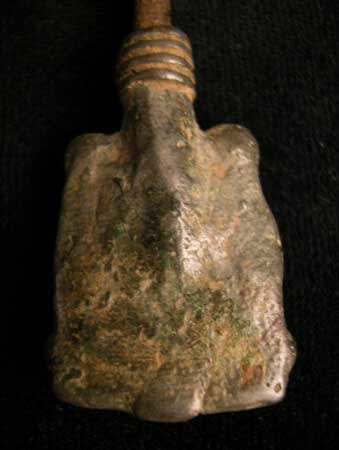Luristan Leopard Head Garment Pin, 900 BCE - 600 CE
Metal Alloy
6.875
FZ.266
Luristan (or Lorestan) literally means “Land of the Lurs”, and was situated in a wide sweep of the Zagros mountains in what is now western Iran. The sociopolitics of this...
Luristan (or Lorestan) literally means “Land of the Lurs”, and was situated in a wide sweep of the Zagros mountains in what is now western Iran. The sociopolitics of this area are complex, with repeated waves and invasions of Medes, Cimmerians and Persians, amongst others, but the culture thus created is remarkable for its superb control of metalworking. There are many styles, but the best-known pieces of bronze from this area are anthropomorphic and zoomorphic pieces reflecting religious and secular tastes, as well as weaponry and utilitarian items that were buried with the deceased in tombs across the Zagros area. It was nonetheless viewed as a precious resource, and was used alongside iron once this metal became available, for while its qualities of hardness and durability were recognized, it merely made bronze a more socially exclusive material. The hallmark of Luristan wares is the tendency to elongate the necks, tails and bodies of the animals to produce graceful curves and arches. The re-discovery of the splendor of Luristan metalwork began in the 1930s and made considerable progress after World War II. The absence of relevant written records makes their complex imagery difficult to interpret in specific religious terms but it is likely that they represent local deities of some kind. It has been suggested that such elaborate bronze items must have been the preserve of the tribal leaders, a warrior class with the means to equip themselves and their households for war.
In an age before buttons or zippers, persons of rank held their clothing together with ornate pins. In ancient Persia, the wealthy adorned themselves with pins of bronze, silver, steel, or other metal alloys. These pins were a part of every well-dressed individual’s wardrobe and were also left as votives at the shrines of the gods. This spectacular example, deriving its motif from nature, is crowned with an abstract leopard’s head. When the shank was pushed into the folds of a robe, the feline head would give the impression of grasping the material in its teeth. In Persia, the leopard was associated with power and nobility. No doubt the person who wore this pin was someone of importance. As we hold it in our hands as they once did, we are connected in an intimate way with their vanished world.
In an age before buttons or zippers, persons of rank held their clothing together with ornate pins. In ancient Persia, the wealthy adorned themselves with pins of bronze, silver, steel, or other metal alloys. These pins were a part of every well-dressed individual’s wardrobe and were also left as votives at the shrines of the gods. This spectacular example, deriving its motif from nature, is crowned with an abstract leopard’s head. When the shank was pushed into the folds of a robe, the feline head would give the impression of grasping the material in its teeth. In Persia, the leopard was associated with power and nobility. No doubt the person who wore this pin was someone of importance. As we hold it in our hands as they once did, we are connected in an intimate way with their vanished world.



